S-37: Difference between revisions
Pbcjohnston (talk | contribs) FInished adding captions |
Pbcjohnston (talk | contribs) Added canary photo |
||
| Line 1: | Line 1: | ||
[[File:S-Boat Header 1.jpg]] | [[File:S-Boat Header 1.jpg]] | ||
<br> | |||
[[File:S-37 accident.jpg|left|500px]] | [[File:S-37 accident.jpg|left|500px]] | ||
<div style="text-align: justify;"><span style="color:#00008B">On the afternoon of October 10, 1923, the newly commissioned S-37 was in port at San Pedro (Los Angeles), CA. She was conducting a battery charge, a seemingly routine activity that can actually turn quite dangerous under the right conditions. About halfway through the charge, an explosion occurred in the after battery compartment. Hydrogen gas is generated when the lead-acid batteries are charged, and it was this highly flammable gas that built up under improper ventilation until a stray spark set it off. Dense black smoke and toxic gas filled the compartment, and flames raged across the deck. Three men were brought out. Two bodies were left behind. One of the rescued died before medical help arrived. Two of the rescuers were seriously injured. The crew battled the fire for several hours unsuccessfully, and finally evacuated and sealed the compartment in an attempt to get the fire snuffed out. It took until 1130 the next day to finally fully extinguish the fire. The after battery compartment was heavily damaged. This photo shows the crew and medical personnel removing the dead and injured through the engine room hatch in the late afternoon of the 10th. Temporary repairs were made, and the boat got underway for the Mare Island Navy Yard near San Francisco where the boat was fully repaired. By mid December, 1923 S-37 was once again back operating with the fleet. | <div style="text-align: justify;"><span style="color:#00008B">On the afternoon of October 10, 1923, the newly commissioned S-37 was in port at San Pedro (Los Angeles), CA. She was conducting a battery charge, a seemingly routine activity that can actually turn quite dangerous under the right conditions. About halfway through the charge, an explosion occurred in the after battery compartment. Hydrogen gas is generated when the lead-acid batteries are charged, and it was this highly flammable gas that built up under improper ventilation until a stray spark set it off. Dense black smoke and toxic gas filled the compartment, and flames raged across the deck. Three men were brought out. Two bodies were left behind. One of the rescued died before medical help arrived. Two of the rescuers were seriously injured. The crew battled the fire for several hours unsuccessfully, and finally evacuated and sealed the compartment in an attempt to get the fire snuffed out. It took until 1130 the next day to finally fully extinguish the fire. The after battery compartment was heavily damaged. This photo shows the crew and medical personnel removing the dead and injured through the engine room hatch in the late afternoon of the 10th. Temporary repairs were made, and the boat got underway for the Mare Island Navy Yard near San Francisco where the boat was fully repaired. By mid December, 1923 S-37 was once again back operating with the fleet. | ||
| Line 20: | Line 20: | ||
<small>Photo in the private collection of Ric Hedman.</small> | <small>Photo in the private collection of Ric Hedman.</small> | ||
[[File:Red bar sub new.jpg]] | |||
[[File:S-37 with canaries.jpg|left|500px]] | |||
This unfortunately poor quality photo shows a very interesting scene. S-37 is underway likely in the South China Sea near the Philippines. The date is approximately 1925-1926. Several crewmembers are topside tending to canaries in cages! This photo comes from the private collection of former crewmember E.J. Hillin, and a caption written on the back of the photo indicates that the boat had just come from Hong Kong and the crew had purchased a number of canaries in that exotic port, with Hillin indicating that as many as 21 birds were aboard the boat for that voyage. The crew brought at least three of the cages topside to give the birds some fresh air. | |||
Sailors in general, but in particular those in the Asiatic Fleet, are renowned for purchasing unusual souvenirs, especially after a few beers had been consumed. Many of the captains were reasonably tolerant of the practice, knowing that the men needed the morale boost in the harsh conditions of the pigboats. However, this is a little over the top and the birds were likely freed into the Philippine jungles shortly after the boat returned to Cavite. The division or squadron commanders would likely take a fairly dim view of having 21 canaries aboard a submarine. | |||
<small>Photo by E.J. Hillin, and now in the private collection of Ric Hedman.</small> | |||
[[File:Red bar sub new.jpg]] | [[File:Red bar sub new.jpg]] | ||
Revision as of 21:02, 18 November 2024

USN photo NH 69128 courtesy of the NHHC.

Photo in the private collection of Ric Hedman.

Photo in the private collection of Ric Hedman.
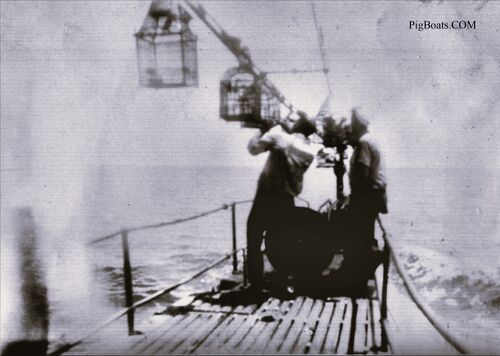
This unfortunately poor quality photo shows a very interesting scene. S-37 is underway likely in the South China Sea near the Philippines. The date is approximately 1925-1926. Several crewmembers are topside tending to canaries in cages! This photo comes from the private collection of former crewmember E.J. Hillin, and a caption written on the back of the photo indicates that the boat had just come from Hong Kong and the crew had purchased a number of canaries in that exotic port, with Hillin indicating that as many as 21 birds were aboard the boat for that voyage. The crew brought at least three of the cages topside to give the birds some fresh air.
Sailors in general, but in particular those in the Asiatic Fleet, are renowned for purchasing unusual souvenirs, especially after a few beers had been consumed. Many of the captains were reasonably tolerant of the practice, knowing that the men needed the morale boost in the harsh conditions of the pigboats. However, this is a little over the top and the birds were likely freed into the Philippine jungles shortly after the boat returned to Cavite. The division or squadron commanders would likely take a fairly dim view of having 21 canaries aboard a submarine.
Photo by E.J. Hillin, and now in the private collection of Ric Hedman.
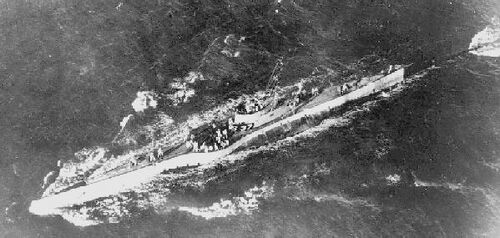
Photo in the private collection of Ric Hedman.
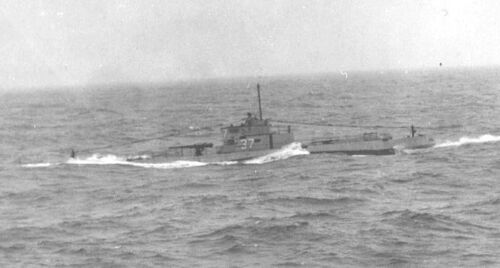
Photo in the private collection of Ric Hedman.
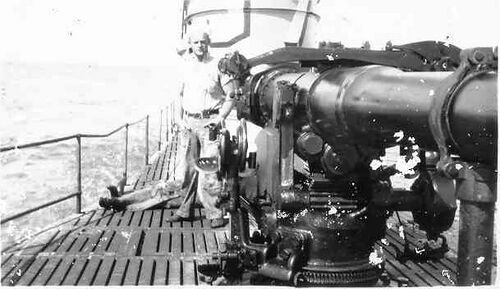
Photo in the private collection of Ric Hedman.
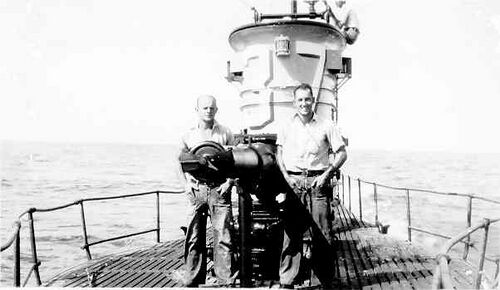
Photo in the private collection of Ric Hedman.
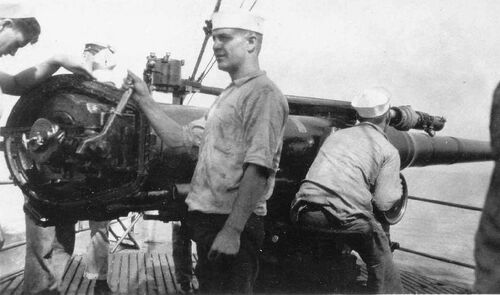
Photo in the private collection of Ric Hedman.
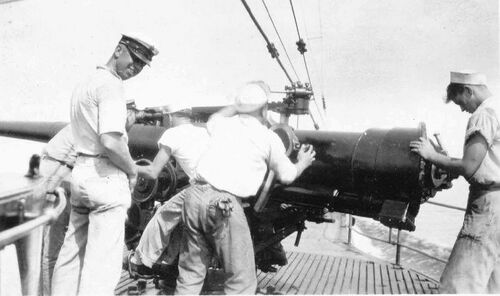
Photo in the private collection of Ric Hedman.
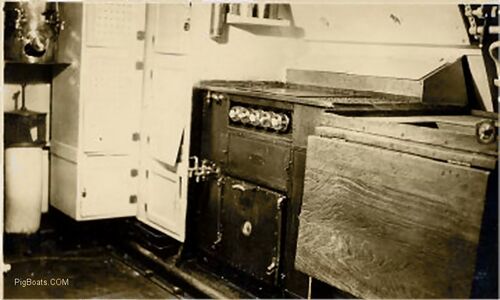
The range is about the size of a large house range and it produced all the food for the crew as many as four times a day. There is a large griddle surface for frying meats, eggs, pancakes, toast, and pretty much anything you'd want to eat. On the right are two flat topped hot plates for cooking in pots and pans. Below is a warming drawer to keep cooked foods warm until served. Below that is the main oven for baking and roasting. On the far left side of the range is a large tank for making hot water with sight glasses and taps.
On the right is the sink that was used for preparing food and washing dishes. In this photo you can see a large, folding cutting board that has been attached to the sink face to increase the amount of room needed for cooking. Space is always at a premium and sub sailors are resourceful people.
This is also the battery compartment and on the deck under the front edge of the stove can be seen the hold downs used to stretch the canvas decking over the boards that were used to cover the battery well. According to men who sailed these boats the decks were a bright green in color.
Photo in the private collection of Ric Hedman.
Page created by:
Ric Hedman & David Johnston
1999 - 2023 - PigBoats.COM©
Mountlake Terrace, WA, Norfolk, VA
webmaster at pigboats dot com
